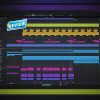
Review: King Korg Neo
Korg has unleashed a fresh take on its 300lb gorilla.
It’s a bit more subtle but thankfully retained: the King Korg Empire State ‘i’ in the logo. When the original King Korg arrived back in 2012/13 it was one of the elements (along with the ‘glowing’ tube behind its front panel grille) that made something clear: this isn’t a synth nerd’s instrument. Rather, it’s a fun and versatile hands-on performer. Don’t get hung up on true analogue or unnecessarily expensive modelled vanity synths (from the likes of Nord or Access at the time), King Korg is all you need. That message was warmly received and the synth became a hit.
The King Korg reboot, the Neo, retains much of what made the original so friendly and fun but in the now-familiar Korg 37-note chassis. Don’t expect teak end cheeks or knurled knobs machined from solid blocks of unobtanium, King Korg Neo is built for mass market appeal – in fact, it’s good value at around A$1500.
BIG KNOBS, MORE SCREENS
One look at the front panel of King Korg Neo is all you need to understand this synth’s proposition. It remains mostly true to the original King Korg: big knobs for big stuff, smaller knobs for parameter changes etc. The new layout retains the two additional OLED screens for the oscillator and filter sections which are most welcome. The way the encoders are set, you can reach out and tweak settings while ensuring smooth transition from the patch preset – it’s forgiving and responsive at the same time.
Three oscillators, three FX engines, two LFOs… the front panel is spacious and easy to navigate. Most of the time, the main screen is really there to show you the preset name. Speaking of which, the 200 presets are all neatly catalogued according to type, with buttons under the main display providing a shortcut. This is such a simple idea and, again, very welcome. For live work, you can save your favourites to those buttons as well. There are 100 user presets, and they can also be categorised.
How could I forget? The King Korg Neo ships with a gooseneck mic that plugs into the XLR socket of the vocoder section. Korg has provided some vocoder-friendly patches but any patch will respond – just activate the vocoder button and wail into the mic.
The mod/pitch joystick is understated but I had no complaints.
ARP’ING ON
With such an emphasis on playability and ease of use, inevitably there are some sacrifices made. For me, it’s the arpeggiator section. There’s what’s effectively the on/off button for the arp but the other settings are so deep in the menu that you might get the bends coming back up for air. The arp patch presets are tasty and will be sufficient for many, but I do wonder if Korg um’ed and ah’ed about offering more hands-on arp control… or indeed adding its customary motion sequencing to the new King Korg package.
So I’m not going to say the lack of arp control is a universal deal breaker, it’s simply a King Korg Neo design choice – it’s up to you if it’s a deal breaker. In fact, any settings that require you to go menu diving is Korg’s way of saying, ‘hey, don’t sweat it too much, stick to the front panel’.
Synth aficionados will also blanche at the constrained modulation possibilities. To clarify, Neo does provide some virtual patching under the bonnet (six sets, in fact, for modulation) but again, it takes a deep dive into the menu.
One of King Korg Neo’s competitors is the MiniFreak from Arturia, and interestingly that hybrid synth has gone the opposite direction with a heavy emphasis on the arpeggiator and a mod matrix. No sweat – choice is a good thing and it’s a buyer’s market out there, what with Modal’s Cobalt being another competitor worth auditioning.
NEED TO KNOW


GET OVER YOURSELF
‘Get over yourself and don’t be seduced by an analogue polysynth,’ would be my advice to a younger me and to anyone looking at their first hardware synthesiser. The synth market is bursting with choice but the King Korg Neo gives you a ‘best of’ smorgasbord of synth textures without locking yourself into any one flavour. And I’m not just focussing on analogue synths. Korg’s recent spate of wave sequencing, wavetable and FM packages are similarly limiting if you’re looking for a true allrounder.
Being digital, King Korg Neo isn’t constrained by analogue synth limitations we all pretend are endearing. With 24 voices on offer you’ll never experience note stealing when you’re punching out complex chords. Tuning will never be a problem. And, let’s face it, reliability is always going to be more of a concern for analogue synths than with a digital instrument like this… especially if you’re gigging with it.
King Korg Neo is a performance synth – easy to operate and fun to play – and with the choice of oscillators and filters will get you close to just about any tone you can think of. If you’re after something quirky or a sound design secret weapon then look elsewhere, but if you require a dependable repository of highly usable sounds from the analogue world and beyond then King Korg Neo is the droid you’ve been looking for.























RESPONSES